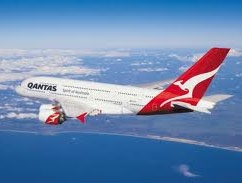Qantas threatens Rolls-Royce as probe reveals engine problem
 |
The Australian Transport Safety Bureau said a misaligned component had thinned the wall of an oil pipe in the engine, causing "fatigue cracking" that prompted leakage and a fire "central to the engine failure" on November 4.
"This condition could lead to an elevated risk of fatigue crack initiation and growth, oil leakage and potential catastrophic engine failure from a resulting oil fire," the ATSB said, noting it was "understood to be related to the manufacturing process".
The Bureau directed Rolls-Royce to "address the safety issue and take actions necessary to ensure the safety of flight operations in transport aircraft equipped with Rolls-Royce Trent 900 series engines".
Qantas initially grounded all six of its Airbus superjumbos after the blast over Indonesia, which forced an A380 to return to Singapore airport trailing smoke.
Qantas said it would immediately conduct further engine investigations as a result of the findings, but stressed this was a precaution and there was "no immediate risk to flight safety".
The airline said it had begun court proceedings to allow it to pursue legal action against Rolls-Royce if necessary, but was also pursuing talks with the British company on the impact on operations of the engine problem.
Qantas "will also consider legal options," it said on its website.
The airline had "filed a statement of claim and been granted an injunction by the Federal Court of Australia which will ensure that the company can pursue legal action against Rolls-Royce in Australia... if a commercial settlement is not possible," the airline said.
"Qantas remains committed to working with Rolls-Royce on the Trent 900 inspection programme, in consultation with Airbus and the Civil Aviation Safety Authority."
Qantas also said it would be inspecting the two A380 planes it currently has in operation following the latest findings.
"Qantas does not anticipate at this stage that the inspections will have an impact on international services. However contingency arrangements will be in place, if needed," it said.
The findings come just five days after Qantas resumed A380 flights, though the carrier has barred the superjumbo from trans-Pacific trips to Los Angeles due to the extra engine thrust required.
Checks revealed problems with 16 of the total 24 Rolls-Royce Trent 900 engines powering Qantas's A380s -- four per plane -- meaning the turbines would have to be replaced or modified.
Singapore Airlines replaced one engine each on three of its 11 A380s as a precaution after the Qantas incident and said Thursday's news was "really nothing new" and would not affect its flights.
"We are already complying with the recommendations from inspectors... This is an ongoing process," an airline spokeswoman told AFP.
SIA said it was not considering taking legal action against Rolls-Royce for the moment.
"As of now I don't think we are, that's not the focus... Our focus right now is on the (engine) checks," a spokeswoman told AFP.
German flag carrier Lufthansa, which also uses the Trent 900 on its fleet of four A380s, has replaced two of the engines, with Qantas last month warning as many as 40 units across the three airlines may have to be replaced.
Airbus has vowed to seek compensation from Rolls-Royce.
The double-decker A380, which carries 525 passengers and weighs 560 tonnes at takeoff, was hailed as the future of long-haul aviation at its commercial launch in 2007.
Qantas chief Alan Joyce on Saturday said he was "100 per cent comfortable" with the A380s' operation. Australia's national carrier, it has has never suffered a fatal crash in the jet age.
The ATSB said it would hand down its full preliminary report into the incident on Friday.
>> Troubled Qantas plane lands in Singapore: AFP reporter
>> Qantas A380: French experts say fault at rear of engine
>> Singapore Airlines grounds three A380s for engine changes
What the stars mean:
★ Poor ★ ★ Promising ★★★ Good ★★★★ Very good ★★★★★ Exceptional
Related Contents
Latest News
More News
- PM urges Ho Chi Minh City to innovate and remain Vietnam’s economic locomotive (November 26, 2025 | 15:29)
- Experts chart Vietnam's digital finance path: high hopes, high stakes (November 14, 2025 | 10:56)
- Vietnam’s seafood imports surge 30 per cent in first 10 months (November 10, 2025 | 19:35)
- Vietnam’s durian exports hit $1 billion milestone (October 30, 2025 | 17:41)
- Beyond borders: Sunhouse and new era of Vietnamese brands on Amazon (October 28, 2025 | 10:46)
- Record-breaking trade fair set to open in Hanoi (October 15, 2025 | 15:59)
- Timber sector seeks solutions to VAT refunds (October 14, 2025 | 18:58)
- Tether explores investment prospects in Vietnam’s digital asset sector (October 10, 2025 | 18:09)
- Vietnamese investors pour nearly $847 million into overseas markets in nine months (October 08, 2025 | 18:42)
- Vietnam amends Law on Civil Aviation to create drive airport investment (October 03, 2025 | 18:29)

 Tag:
Tag:





















 Mobile Version
Mobile Version